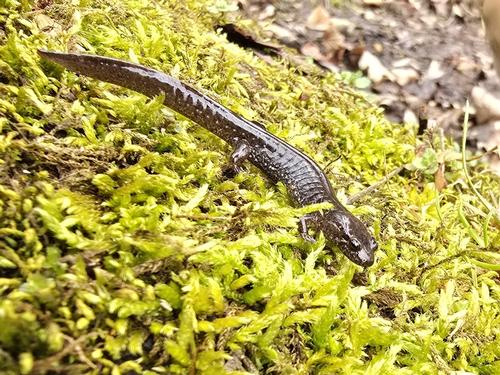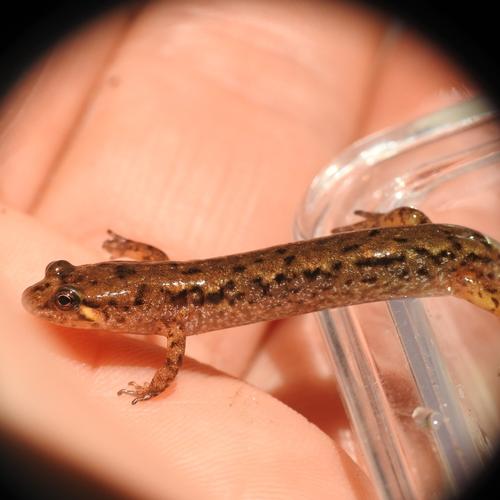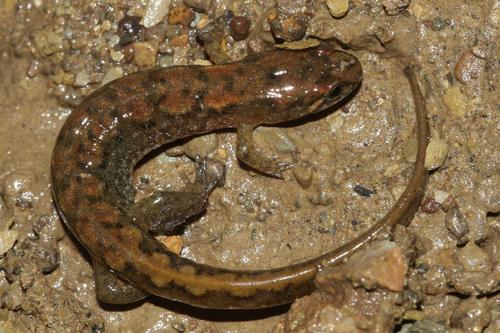Plants and Animals
Desmognathus fuscus Northern dusky salamander
Key Characteristics
The Northern Dusky Salamander is a small to medium-sized, thick-bodied salamander with adults reaching 2.5–5.6 inches (6–14.2 cm) in length. Its name refers to its dark coloration, which varies from tan or reddish-brown to gray or olive, with mottled dark stripes along the sides and back. A light stripe extends from the eye to the back of the jaw, and the underbelly is whitish with gray flecks. The hind limbs are noticeably larger than the forelimbs. The tail is laterally flattened like a paddle, is keeled and triangular in cross section, and typically has a light stripe that runs along the dorsal anterior portion of the tail.
Status and Rank
US Status: No Status/Not Listed
State Status: SC - Special Concern (rare or uncertain; not legally protected)
Global Rank: G5 - Secure
State Rank: SNR - Not ranked
Occurrences
| County | Number of Occurrences | Year Last Observed |
|---|
Information is summarized from MNFI's database of rare species and community occurrences. Data may not reflect true distribution since much of the state has not been thoroughly surveyed.
Habitat
The Northern Dusky Salamander is a stream-dwelling species, usually found in or near small, clean, headwater streams, springs, and/or seep environments in forested areas. They tend to be associated with closed-canopy deciduous or coniferous forests. They are commonly found under rocks, logs, and leaf litter near streams and seeps, and occasionally under submerged rocks and debris. They overwinter in underground retreats or in streams. In Michigan, this species is known to occur in and along several streams within only one site in the state, which is characterized by rolling hills and forests dominated by eastern hemlock (Tsuga canadensis).
Downed woody debris and other natural ground cover objects (such as rocks, moss, and leaf litter) are needed year-round for protection from predators, foraging, nesting, and avoiding desiccation.
Natural Community Types
For each species, lists of natural communities were derived from review of the nearly 6,500 element occurrences in the MNFI database, in addition to herbarium label data for some taxa. In most cases, at least one specimen record exists for each listed natural community. For certain taxa, especially poorly collected or extirpated species of prairie and savanna habitats, natural community lists were derived from inferences from collection sites and habitat preferences in immediately adjacent states (particularly Indiana and Illinois). Natural communities are not listed for those species documented only from altered or ruderal habitats in Michigan, especially for taxa that occur in a variety of habitats outside of the state.
Natural communities are not listed in order of frequency of occurrence, but are rather derived from the full set of natural communities, organized by Ecological Group. In many cases, the general habitat descriptions should provide greater clarity and direction to the surveyor. In future versions of the Rare Species Explorer, we hope to incorporate natural community fidelity ranks for each taxon.
Management Recommendations
Conservation actions for the Northern Dusky Salamander should focus on protecting the streams and surrounding forests with known populations in Michigan. The species is an important indicator of healthy streams, springs, and seeps, and does not fare well in areas with high disturbance. Maintaining intact streams and forested habitat with natural ground cover objects and uninterrupted surface and groundwater flow is essential. Sustainable forestry practices that include longer rotation cycles are recommended, and a minimum 100-ft (30-m) riparian buffer should be preserved to prevent erosion of banks and stream sedimentation. Land clearing and road construction should be avoided near streams and seeps with known populations to avoid or reduce the potential for hydrological changes, increased sedimentation, stream scouring, and chemical pollution. Exposure to stream and groundwater contamination from surface runoff should be minimized to protect water quality and prevent degradation of larval habitats. Timber harvesting and forest management practices can occur outside of the stream/riparian buffer, but extra caution should be taken when these management practices are conducted adjacent to the stream buffer during times of the year when individuals of this species are most active (i.e., April to June and September to October). Release of native or non-native fish and amphibians (e.g., fish stocking, pet releases) into streams with known populations of this species should be avoided to reduce the potential for increased predation and/or the introduction of disease (e.g., chytridiomycosis). Additional surveys are recommended to determine if this species occurs in additional locations in the state.
Active Period
Active from first week of April to fourth week of October
Breeding from first week of April to fourth week of June
Breeding from first week of September to fourth week of October
Nesting from first week of June to fourth week of August
Survey Methods
The recommended time for surveying for Northern Dusky Salamanders is during their spring and fall courtship and breeding seasons. Visual encounter surveys (VES) for adults can be conducted by carefully looking under rocks, logs, and other cover objects in streams and along streambanks. Artificial cover boards also can be placed along stream edges to detect adults. Boards should be checked between mid-morning and early afternoon at least two times per week. Visual surveys for larvae can be conducted in shallow streams using dip nets or by carefully turning of rocks. Larval surveys should be conducted during the day.
Cover board survey
Survey Period: From first week of April to fourth week of October
Humidity: Humid
Wind: Light Breeze
Survey Method Comment: The species is less active between July and August. Surveys should be conducted in the morning, late evening, or at night when individuals become more active.
Dip net survey
Survey Period: From first week of July to fourth week of October
Humidity: Humid
Wind: Light Breeze
Survey Method Comment: This survey method can detect larvae. Surveys should be conducted in the morning, late evening, or at night when individuals become more active.
Visual encounter survey during fall breeding season
Survey Period: From first week of September to fourth week of October
Humidity: Humid
Wind: Light Breeze
Survey Method Comment: This survey method can detect adults and larvae. In closed canopy, shaded areas, dusky salamanders will forage and be active in almost any weather condition. However, in areas with direct sunlight, they will hide under shelter and be more active at night. Surveys should be conducted in the morning, late evening, or at night when individuals become more active.
Visual encounter survey during spring breeding season
Survey Period: From first week of April to fourth week of June
Humidity: Humid
Wind: Light Breeze
Survey Method Comment: This survey method is primarily for adults. In closed canopy, shaded areas, dusky salamanders will forage and be active in almost any weather condition. However, in areas with direct sunlight, they will hide under shelter and be more active at night. Surveys should be conducted in the morning, late evening, or at night when individuals become more active.
References
Survey References
- Crump, M.L. and N.J. Scott Jr. 1994. Visual encounter surveys. In: W.R. Heyer, M.A. Donnelly, R.W. McDiarmid, L.C. Hayek, and M.S. Foster, eds. Measuring and Monitoring Biological Diversity: Standard Methods for Amphibians. Smithsonian Institution Press, Washington, D.C. pp. 84–92.
- Grover, M.C. 2006. Comparative effectiveness of nighttime visual encounter surveys and cover object searches in detecting salamanders. Herpetological Conservation and Biology 1(2):93–99.
- Yoder, T.A. 2007. A comparison of two survey methods for terrestrial salamanders: Species and seasonal differences. Master’s thesis, University of Michigan–Flint. Murphy Lake State Game Area, Tuscola County, Michigan.
Technical References
- Barrett, K. and S.J. Price. 2014. Urbanization and stream salamanders: A review, conservation options, and research needs. Freshwater Science 33(3):927–940.
- Harding, J.H. and D.A. Mifsud. 2017. Amphibians and Reptiles of the Great Lakes Region. University of Michigan Press.
- Juterbock, J.E. 1986. The nesting behavior of the dusky salamander, Desmognathus fuscus. I. Nesting phenology. Herpetologica 42:457–471.
- Myers, P., R. Espinosa, C.S. Parr, T. Jones, G.S. Hammond, and T.A. Dewey. 2025. Desmognathus fuscus (Northern dusky salamander). Animal Diversity Web. University of Michigan Museum of Zoology. Accessed July 03, 2025.
- Peterman, W.E., and R.D. Semlitsch. 2009. Efficacy of riparian buffers in mitigating local population declines and the effects of even-aged timber harvest on larval salamanders. Forest Ecology and Management. 257(1), 8-14.
- Petranka, J.W. 1998. Salamanders of the United States and Canada. Smithsonian Institution Press, Washington, D.C. 587pp.
- Sweeten, S.E. and W.M. Ford. 2015. Effects of microhabitat and land use on stream salamander abundance in the southwest Virginia coalfields. In: 2nd Proceedings of Environmental Considerations in Energy Production. Society for Mining, Metallurgy & Exploration, Englewood, CO. pp. 122–140.




